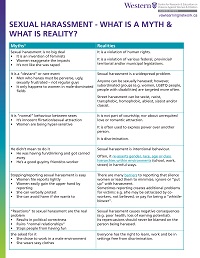Sexual Harassment - What is a Myth and What is Reality?

This infographic distinguishes commonly held myths from the realities of sexual harassment.
View Infographic(PDF)
View Infographic(Image)
View Plain Text PDF
Myths |
Realities |
Sexual harassment is no big deal
|
It is a violation of human rights. It is a violation of various federal, provincial/territorial and/or municipal legislations. |
It is a “deviant” or rare event
|
Sexual harassment is a widespread problem. Anyone can be sexually harassed; however, subordinated groups (e.g. women, LGBTQ people, people with disabilities) are targeted more often. Street harassment can be sexist, racist, transphobic, homophobic, ableist, sizeist and/or classist. |
It is “normal” behaviour between sexes
|
It is not part of courtship; nor about unrequited love or romantic attraction. It is often used to express power over another person. It is discrimination. |
|
He didn’t mean to do it
|
Sexual harassment is intentional behaviour. Often, it re-asserts gender, race, age or class hierarchies within environments (school, work, street) in harmful ways. |
Stopping/reporting sexual harassment is easy
|
There are many barriers to reporting that silence women or lead them to minimize, ignore or “put up” with harassment. Sometimes reporting creates additional problems for victims: e.g. s/he may be ostracized by co-workers, not believed, or pay for being a “whistle-blower”. |
Reactions” to sexual harassment are the real problem
|
Sexual harassment causes negative consequences (e.g. poor health, loss of earning potential). Its repercussions should never be blamed on the person being harassed. |
She asked for it
|
Everyone has the right to learn, work and be in settings free from discrimination. |
This infographic emerged from Issue-Based Newsletter 13: Sexual and Gender-based Harassment.
Interested in using Learning Network resources?
All our resources are open-access and can be shared (e.g., linked, downloaded and sent) or cited with credit. If you would like to adapt and/or edit, translate, or embed/upload our content on your website/training materials (e.g., Webinar video), please email us at gbvln@uwo.ca so that we can work together to do so.
All our resources are open-access and can be shared (e.g., linked, downloaded and sent) or cited with credit. If you would like to adapt and/or edit, translate, or embed/upload our content on your website/training materials (e.g., Webinar video), please email us at gbvln@uwo.ca so that we can work together to do so.






